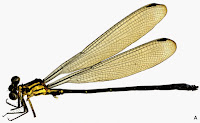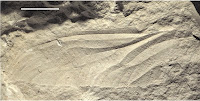The
Satovcha Graben (depression formed by extension, as two geological
blocks draw apart causing the ground between to thin and slump) forms
a basin roughly 7 km in length and 1.5 km in width in the western
Rhodopes Mountains of southwest Bulgaria. During the
Miocene-Oligocene this depression was filled by a lake, and
surrounded by subtropical evergreen forests similar to those found in
Southeast Asia today. These deposits have produced a diverse range of
Plant fossils preserved in freshwater diatomites (sedimentary rocks
made up of the tests, or shells, of tiny planktonic Algae called
Diatoms). The site is also known to produce Insect fossils, including
Beetles, Coleoptera, Bugs, Hemiptera, Caddisflies, Trichoptera,
Earwigs, Dermaptera, Ants and Bees, Hymenoptera, Flies including
Mosquitoes, Gnats and Midges, Diptera, Cockroaches and Termites,
Dictyoptera, a Grasshopper and Crickets, Orthoptera, and Dragonflies
and Damselflies, Odonata; though to date these Insects have never
been formally described or studied in any organized way.
In a
paper published in the journal Palaeontologica Electronica in
September 2016, Andre Nel of thr Institut de Systématique,Évolution, Biodiversité at the Muséum national d’Histoirenaturelle, Nikolay Simov of the National Museum of Natural History in
Sofia, Vladimir Bozukov of the Institute of Biodiversity andEcosystem Research at the Bulgarian Academy of Sciences, and Milen
Marinov of the Plant Health & Environment Laboratory of the
Ministry for Primary Industries in Auckland, New Zealand, describe
two new species of Dragonfly and a species of Damselfly from the
Middle Miocene Sivik Formation of the Satovcha Graben.
The first
Dragonfly species described is placed in the genus Oligaeschna,
which has previously been described from other locations of similar
age, and given the specific name bulgariensis,
meaning 'from Bulgaria'. The species is described from two specimens,
though both of these comprise the forewing only, one specimen
preserved as part and counterpart on s split block, the second as
part only. Insects in most groups can be identified to species level
using the venation on the their forewings, so it is not unusual to
describe new fossil species using isolated forewings.
Oligaeschna bulgariensis. (1) First specimen (part); (2)
Second specimen (counterpart); (3) Second specimen. Scale bars
represent 5 mm in all figures. Nel et al. (2016).
The second new Dragonfly species described is placed in the genus
Stenolestes, which has previously been described from the
Middle Oligocene to Early Miocene of Europe and Siberia, making this
potentially the youngest example of the genus, and given the specific
name rhodopensis, meaning 'from Rhodopes'; in reference both
to the Rhodopes Mountains and the mythical Thracian queen Rhodope.
The species is described from an isolated forewing preserved as part
and counterpart, plus a largely intact insect compressed in lateral
(side) view.
Stenolestes rhodopensis, whole Insect. Scale bar is 1 cm.
Nel et al. (2016).
The new Damselfly species is placed in the genus Primorilestes,
which has previously been used to describe species from the Early
Oligocene of Primorye Territory in Russia and Early Eocene of
Denmark, and is given the specific name magnificus, in
reference to the quality of preservation on the frst specimen. The
species is described from two specimens, a forewing preserved as part
and counterpart, and an isolated wing-tip.
Primorilestes magnificus, first specimen (part). Scale bar
is 5 mm. Nel et al. (2016).
See also...
 A new species of Clubtail Dragonfly from Malaysian Borneo. Clubtail Dragonflies, Gomphidae, are a group of small-to-medium-sized
Dragonflies related to Damselflies which get their name from a widening
the end...
A new species of Clubtail Dragonfly from Malaysian Borneo. Clubtail Dragonflies, Gomphidae, are a group of small-to-medium-sized
Dragonflies related to Damselflies which get their name from a widening
the end... A new species of Damselfly from the La Montaña de Corazal Cloud Forest of Honduras. Damselflies (Zygoptera) are members of the Dragonfly order (Odonta),
though generally smaller...
A new species of Damselfly from the La Montaña de Corazal Cloud Forest of Honduras. Damselflies (Zygoptera) are members of the Dragonfly order (Odonta),
though generally smaller... A Dragonfly from the Late Jurassic of Central Poland.
Dragonflies are one of the oldest groups of insects with a fossil record that dates back to the...
A Dragonfly from the Late Jurassic of Central Poland.
Dragonflies are one of the oldest groups of insects with a fossil record that dates back to the...
Follow Sciency Thoughts on
Facebook.



